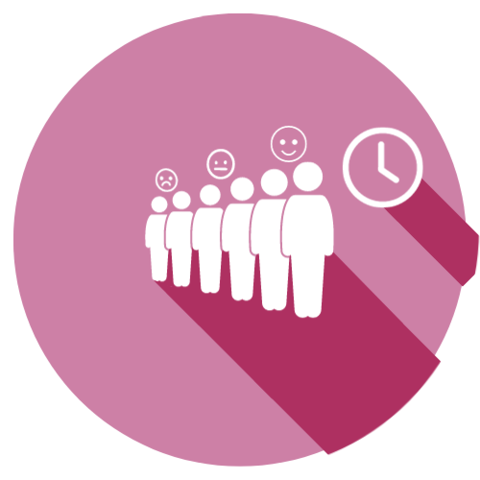Why Extended Wait Times Can Benefit the Consumer Experience
Relevant topics Research, Archive
Imagine hurriedly entering the supermarket with a shopping list in hand, determined to exit swiftly. You scan the cash registers, seeking the shortest queue. However, just as you think you've made the fastest choice, you realize the wait time is longer than expected. Frustrating. Or is it?
Contrary to common belief that a linear relationship exists between wait time expectations and consumer satisfaction, waiting longer than expected isn't always detrimental to customer satisfaction. In this blog, we delve deeper into the relationship between waiting, expectations, and customer satisfaction.
Wait Time Expectation
Before customers have a service experience, they form expectations about how long they will have to wait. In reality, the wait time often differs from these expectations. When customers wait longer or shorter than expected, they experience a respective positive or negative 'disconfirmation.' Waiting shorter than expected is seen as positive, while waiting longer than expected is considered negative.
Value of Time
How customers react to wait times depends on the value they attach to their time. If people consider their time valuable, they will react more positively to time savings and negatively to time losses. This reaction not only varies from person to person but also depends heavily on the situation and context. We don't express the value of time in a monetary form like an hourly wage but rather in what we could have done during that time. As subjective beings, we tend to lean toward the most advantageous scenario. For instance, standing 4 minutes shorter in line at the supermarket than expected is a welcome bonus: 4 minutes saved!
But even if a good or service disappoints, we still opt for the most advantageous scenario: the time we invested extra wasn't really worth that much. After all, what could you truly have accomplished in those extra 4 minutes you had to wait longer at the supermarket?
As it turns out, Caruellea, Lervik-Olsen and Gustafsson (2023) found that customers react less strongly to the negative experience of waiting longer than expected, while the positive experience of waiting shorter than expected yields a significant boost in satisfaction. The satisfaction derived from a positive disconfirmation is even 1.66 times greater than the decrease in satisfaction from a negative disconfirmation.
Internal vs. External Expectations
Now we know that expectations play a key role in how we experience wait times. Whether these expectations are internal (based on our own past experiences) or external (for example, a wait time communicated by the company) influences how we experience positive or negative wait surprises. Positive surprises seem to carry more weight than negatives when based on internal expectations. Conversely, when expectations are based on an external source, the opposite occurs. If the wait time is longer than expected, dissatisfaction is greater than satisfaction when the wait time is shorter than expected. Customers perceive the longer wait time as a violation of the promise; the company has, in a sense, 'lied' about the wait time.
Zone of Indifference
However, a small difference between expected and actual wait times still has little impact on customer satisfaction. The difference in wait time essentially falls within the Zone Of Indifference (ZOI), a range of disconfirmations that still feel acceptable. Only when the wait time longer than expected surpasses the Zone of Indifference (ZOI) does this elicit a stronger negative reaction from customers. In the study of Carcuellea et al. (2023), they found that customer satisfaction was truly strongly affected when they had to wait 238% longer than expected.
Well, What Does That Mean for Queue Management in Stores?
These findings assist in determining wait time thresholds in stores. Okay, extended wait times do not actually benefit the consumer experience. However, it doesn’t necessarily imply that it is disadvantageous, and extending the expected wait time can have a positive outcome. Because waiting slightly longer than expected doesn't immediately harm customer satisfaction, that threshold can be slightly higher than the average expected wait time.
Especially in staff shortages, this saves unnecessary deployment of personnel. However, it might be worthwhile to go that extra mile. Waiting slightly shorter than expected results in significantly more satisfaction than when the wait time turns out to be exactly as expected. This way, you take that extra step for your consumer, providing them with a significantly more positive shopping experience.
Although waiting slightly longer or shorter than expected may not affect customer satisfaction, offering a wait time has benefits for physical and digital retailers. When customers wait exactly as expected, their satisfaction is much greater than when no wait time is offered. However, it is crucial that a longer wait time does not go beyond the Zone of Indifference, as at this turning point, the negative impact on customer satisfaction suddenly becomes significant.
In conclusion, understanding the psychological dynamics of waiting, managing expectations, and strategically navigating wait times can have profound implications for both optimizing operational costs and enhancing customer satisfaction in retail settings.
Take home points
- Waiting shorter than expected boosts customer satisfaction 1.66 times more than waiting longer than expected decreases customer satisfaction.
- When expected waiting time is externally instead of internally, this reverses.
- Customer satisfaction is truly strongly negatively affected when customers have to wait 238% longer than expected.
- Applying this knowledge in physical and digital stores strategically is important for customer satisfaction.

